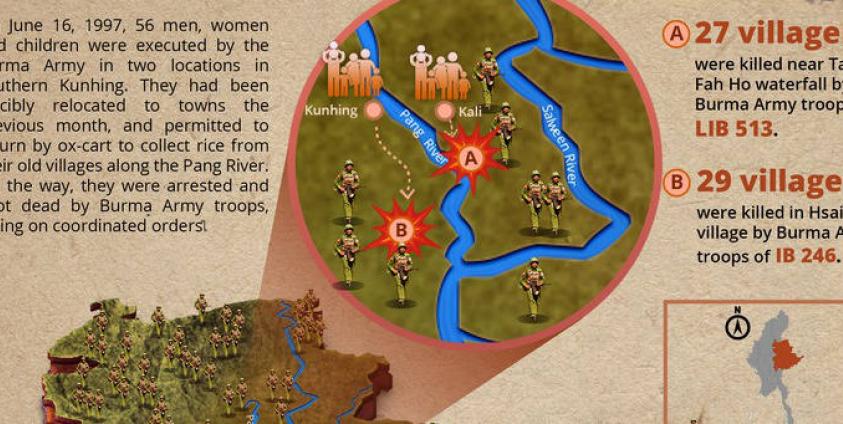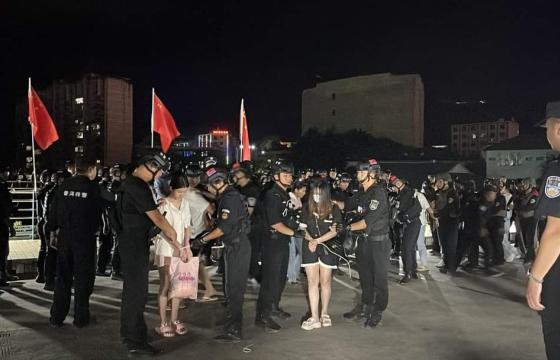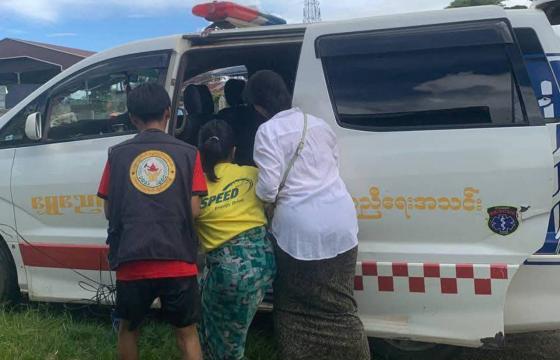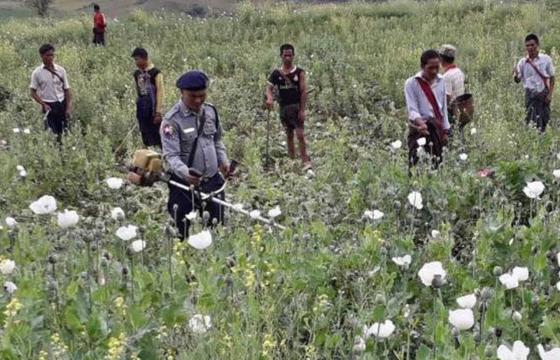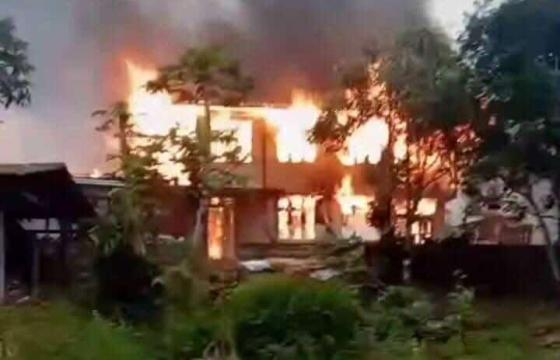Sai Wansai — It is fitting yet heartbreaking to designate and commemorate June 16 as Shan Human Rights Day which coincide with the massacre of 56 Shan villagers in Kunhing Township 23 years ago. It is long overdue that this tragedy is appropriately recorded in recent contemporary Shan history.
It is also appropriate that Shan people commemorated the tragedy, where the youth and civil society organizations organized memorial and merit-making ceremonies to mark the day in Taunggyi, Muse, Hsipaw, Tachilek in Shan State, and Chiang Mai in Thailand, according to the recent SHAN report.
“On June 16, 1997, 56 men, women and children were executed by the Burma Army in two locations in southern Kunhing. They had been forcibly relocated to the town the previous month, and permitted to return by ox-cart to collect rice from their old villages along the Pang River. On the way, they were arrested and shot dead by Burma Army troops, acting on coordinated orders: 29 villagers were killed by troops of IB 246 at Hsai Khao, and 27 were killed near Tard Fah Ho waterfall by troops of LIB 513. The bodies were just left in the open to rot,” writes the statement of 17 Shan community groups to mark the 23rd commemoration.
Likewise, Committee for Shan State Unity (CSSU) also issued a statement saying: “In Shan State, member of the Union, serious and widespread war crimes were meted out from 1996 to 1998 (against the population). Devastation of 1400 villages in 11 townships; and sexual aggression against more than 600 women where some were murdered (by the Burma Army).”
“On 16 June 1997, 56 men and women were murdered in southern Shan State Kunhing Township. They were burned together with their buffaloes, cows and properties, which were tragedies that will remain a historical black mark,” the statement added.
“With the aim that the said historical tragedy will not happen again and internal peace take place soon; to wash away (bring justice) the intruder-aggressors’ guilty sin debts; to comfort the families of the innocent civilian victims; to remember the death of innocent civilians; (CSSU hereby) announced June 16 to be designated as Shan Human Rights Day,” writes the statement in its intended clarification.

Background
The Burma Army launched 1996-1998 clearance operations to get rid of the Shan resistance from central Shan State, which uprooted over 400,000 people in 15 townships.
In 1997, in addition to expanding the area of forced relocation, the regime’s troops also began systematically killing villagers caught outside the relocation sites in a program to deter others from going back to their original villages.
One instance that led to the designation of Shan Human Rights Day was described by Shan Human Rights Foundation, in its ““Dispossessed – A report on forced relocation and extrajudicial killings in Shan State, Burma,” published in April 1998 as:
For example, on June 16, 1997, two groups of villagers who had been relocated to the town of Kun Hing were given permission to return to their old villages to collect rice. They left in two convoys of ox-carts. Both groups were stopped on the way by SLORC troops; one near Sai Khao, one near Tard Pa Ho waterfall. In one group, 29 of the villagers were massacred, in the other 27. One of the survivors, a woman with a small child, who was spared, related the horror of the massacre:
“We were made to stay in a house..They (the SLORC troops) came to the door and called out the people one by one. They called away 16 people first, 12 men and 4 women. Then they came and called another group of 10…Then to the west I heard bursts of machine gun fire. They were killing the 16 people. Then after just a bit I heard gunfire nearby…In the group of 10 my husband died. In the group of 16 my younger sister and her husband died…I was sure I would be killed too..I was shaking, shaking! I was sitting and shaking all the time. My blood was hot all over my body.
I could not think properly. I would have run away but they were standing there guarding me…I think I would be dead if I hadn’t had my son with me. One of the women who was killed had left her baby at home. She squeezed out milk from her breast to show she had a baby, but the SLORC commander said that her baby must have died (and killed her anyway).” (KHRG interview with villager from Keng Kham, August 30, 1997)
Actual extra-judicial killing count
While the single Kunhing Township’s massacre recorded 56 men and women were killed, the actual extra-judicial killings were more than 600, according to conservative estimate.
Shan Human Rights Foundation recorded the following breakdown on massacre of the Shan people in 1997 in its “Dispossessed” report as below:
Kun Hing 319
Nam Zarng 159
Lai Kha 58
Ke See 45
Murng Kerng 17
Murng Nai 23
Larng Kher 5
Murng Pan 37
Loi Lem 1
Total number of people killed 664
(Note: This is only the confirmed total. It is believed that many other killings have gone undocumented.)
Deprivation of civilian rights
According to the 17 Shan community groups’ statement of June 16, various deprivation of civilian rights for the dislocated Shan people are pointed out as the following.
“To this day, there has been no justice for these massacres, nor for the torture, rape and killing of hundreds of other civilians by the Burma Army during their 1996-1998 clearance operations, which uprooted over 400,000 people in 15 townships.”
“This is why over 100 villages in southern Kunhing remain deserted till today. Their former inhabitants, who fled to Thailand over 20 years ago, dare not return while the Burma Army remains in their land, with an ongoing licence to torture, rape and kill with impunity.”
“These tens of thousands of former Kunhing inhabitants were not counted in the 2014 census, had no right to vote in the 2010 and 2015 elections, and will be likewise disenfranchised in this year’s elections.”
“The expulsion and disenfranchisement of local populations is a key strategy of the Naypyitaw government to occupy and exploit the resource-rich ethnic lands, enabling them to push ahead with damaging megaprojects such as the giant Mong Ton dam on the Salween river — whose reservoir will submerge the original villages of those massacred in June 1997.”
“The Mong Ton dam is a joint investment of Chinese and Thai state-owned companies, planned for export of power. Until today, Burma Army troops are continuing to patrol around the dam-site, committing abuses against local civilians.”
Outlook
As the situation now stands, the concern of the Shan community groups to reinstate the civilian rights of the dislocated Shan people, regain back their land, rebuild and repopulate their towns and villages are not in the agenda of the Bamar-dominated government in Naypitaw for several reasons.
In every aspect, the Shan agony and massacre of 1996 to 1998 is no less important than the Rohingya issue that drove some 700,000 into exile and thousands perhaps killed with genocide intent.
While the media coverage and world attention is fixed on Rohingya problematic, we should also highlight the past and present atrocities of Burma Army not only in Shan State but also in Karen, Kachin, Chin and recently in Arakan states by local human rights groups.
For now, the human rights abuses, including extra-judicial killings, are the order of the day in most ethic states. And it goes without saying that only justified political settlement will end all the woes surrounding the country. And to do this repentance and political will from the government are badly needed, which until today are nowhere to be seen.
Hopefully, the powers that be in Naypyitaw will come to its sense that running a multi-ethnic state through military might, with suppression pinned on Bamar racial supremacy, will only have an opposite effect of the country’s disintegration and not reconciliation, as the Khunhing massacre commemoration has showed us.



